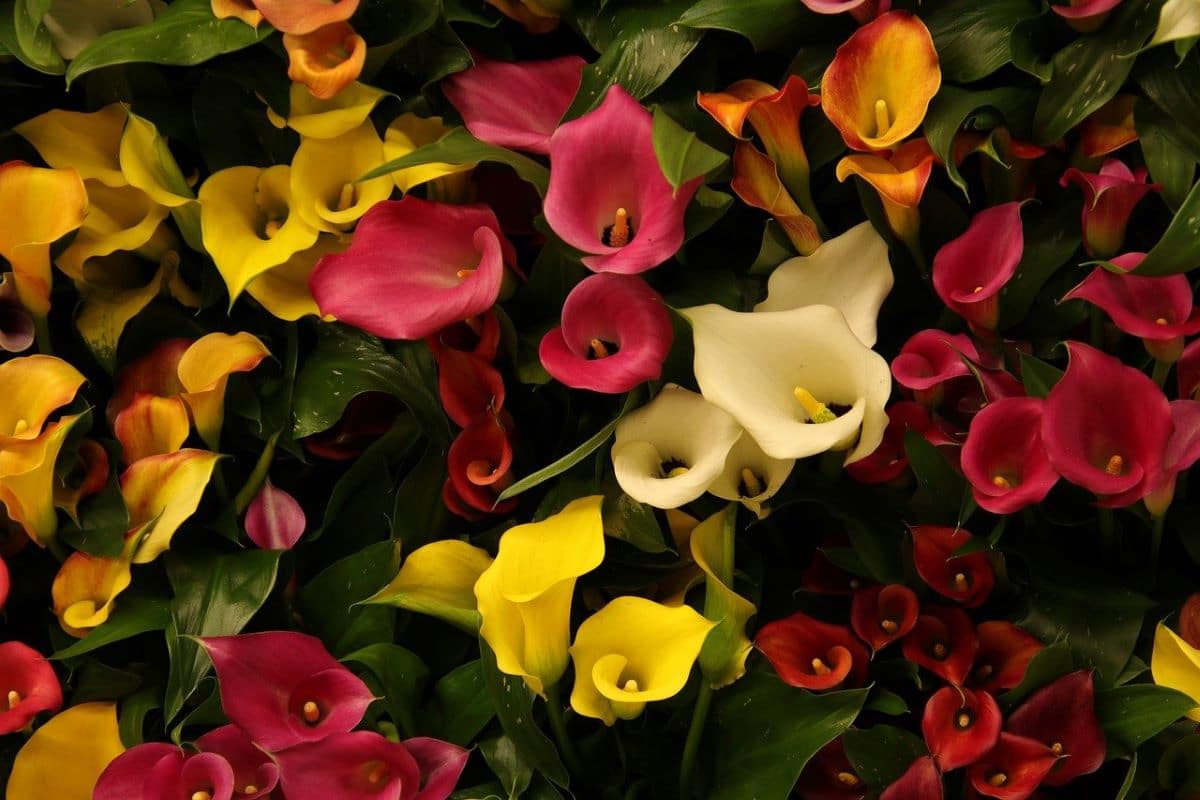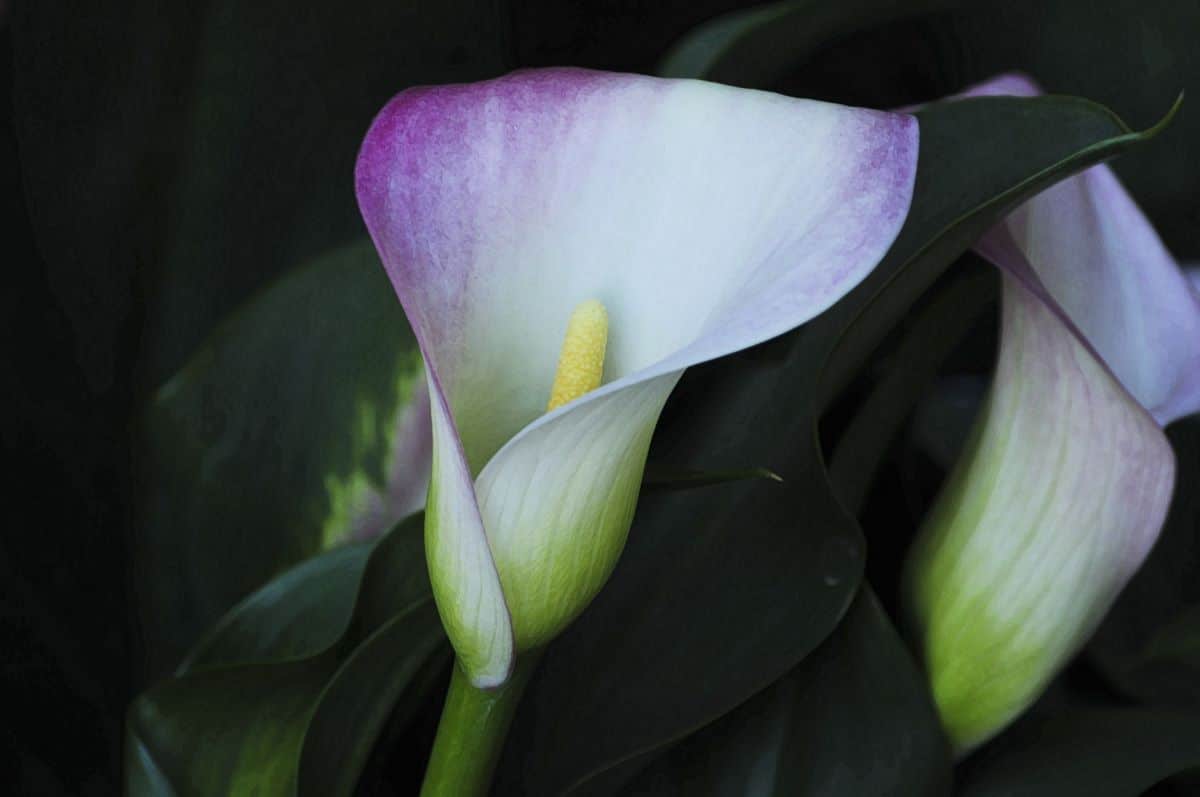
Colored calla lilies are very decorative plants, which is why they are a highly recommended option if you want to expand the variety of colors in the garden or indoors, even if only for a few months a year.
Although they have colorful flowers, we do not have to worry too much when it comes to maintaining them, since they are cared for in the same way as the white or common calla lily. Don't you know what those cares are? Nothing happens. Next you will discover everything about them, and not just when they are watered or how they are paid.
Where do the colored coves come from?

Although we might think that they are different varieties, really we are talking about cultivars that Zantedeschia spp, a genus of rhizomatous plants in the Araceae family that live naturally in Africa. The most common species is the Zantedeschia ethiopicaKnown as cala blanca or alcatraz, but there are others that also have very beautiful flowers, such as the Zantedeschia elliotiana, which produces it yellow.
But the colored coves, although they look quite similar to the pure varieties, like the ones just mentioned, they are smaller. In fact, we could almost say that they are the dwarf versions of those. And is that they barely exceed 50 centimeters in height (the Z. aethiopica can reach the subway). In addition, they have small and narrow leaves, about 20 centimeters long by 3-4 centimeters wide, with or without white spots.
If we talk about flowers, are formed by a bract -a modified leaf that fulfills the same functions of the petals-. which measures about 5-7 centimeters. This can be yellow, lilac, red or orange.
What is the care for colored calla lilies?
They are perfect plants to grow in pots, or to create compositions in planters or on the ground. They look very good in practically any place, since they are also so grateful that they will not demand much attention from us.
But let's see how the colored coves have to be taken care of so that we can enjoy them without any problem:
Location
It is very important that are located in bright areas. If they are to be grown outdoors, we will put them in semi-shade, where they are exposed to direct sunlight only during the first hours of the morning.
If, on the other hand, they are going to be at home, they must be placed in a room where there are windows through which sunlight enters.
Soil or substrate

Calla lilies, regardless of the species or cultivar, are plants that grow in rich, well-drained soils. For this reason, we recommend the following:
- If they are going to be in pots, use the following mixture: mulch (for sale here) + 50% perlite.
- If they will be on the ground, planting holes will be made large enough for the plants to fit well. In the event that the soil has poor drainage (that is, it takes a long time for the water to be absorbed), a hole will be made twice as large, and it will be filled with the mixture mentioned above.
Irrigation
Water your colored coves frequently. These are semi-aquatic plants, which need the soil to be kept slightly moist while they are growing and blooming. Therefore, you have to water them 2 or 3 times a week, except if you have them indoors.
Indoors the soil stays moist much longer than outside, so you only need to water 1, or at most twice a week. If you once placed a plate under the pot, drain it after each watering.
Subscriber
To ensure that the colored calla lilies produce quality flowers, and that these last as many days as possible, it is highly advisable to pay them throughout the season, for example with a fertilizer for flowering plants. Now, organic fertilizers will also be very useful, such as seaweed extract (for sale here) or guano.
Plagues and diseases
These plants have these enemies: snails, slugs, spider mites and botrytis. The first two are mollusks that we will find in the garden, patio and terrace, especially during rainy days, feeding on the leaves of the plants. To avoid this, they have to wear repellants, such as this.
In the case of the Red spider, we are talking about a mite that loves dry environments and high temperatures, so that it is more active in spring and summer than the rest of the year. Since our protagonists are small, if cobwebs appear between their leaves, and / or discolored spots, we can clean it with water and neutral soap.
Por último, la botrytis It is a fungus that, in addition to appearing outdoors, can also be seen indoors since it favors humidity. For this reason, it is important that the land is not flooded, since otherwise the colored coves will get sick. If we see that the leaves and the stem are rotting, the affected parts will have to be cut and treated with fungicide.
Multiplication
It is possible to multiply them if the rhizome is divided, at the end of winter. To do this, you have to dig it up, clean it a bit, and look for bumps or "bumps", since the stems will sprout from them and later the leaves and flowers. Once located, the rhizome is cut into pieces, ensuring that each one has at least one protrusion. The pieces are then planted in individual pots, with a substrate such as vermiculite or coconut fiber.
To finish, they have to be placed in a bright place but without direct contact, and water thoroughly, until the soil is moist.
Plantation
These are plants that they are to be planted in late winteras they bloom in spring. If you buy a pot with colored calla lilies in bloom, you can move them to slightly larger pots or to the garden as long as you don't manipulate the roots.
Rusticity

The rhizomes resist frosts down to -10ºC. If you live in a colder place, you will need to remove it, clean it, and store it in a dark, dry area.
Do you like colored coves?